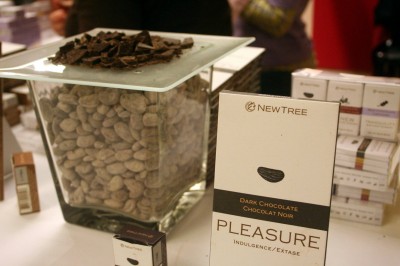Save Our Chocolate!

Graphic: Candy Blog
Should olive oil that’s mixed with canola oil be marketed as “pure olive oil?” Should red wine that’s diluted with grape juice still be called wine? Of course not! If the FDA has its way, something similar could happen to chocolate. Under a new proposal, the FDA wants to label something chocolate if it has NO cocoa butter.
As stated before, dark chocolate is a mixture of cocoa mass (aka chocolate liquor or paste), sugar, cocoa butter, vanilla and an emulsifier (usually soy lecithin). Cocoa butter literally makes chocolate melt in your mouth. Cheap brands substitute a portion of cocoa butter with butter, milk or vegetable fats, and they already taste really bad. Imagine if all the fat came from partially hydrogenated vegetable oil. Mmm, trans fats.
Good chocolate is sacred. The proposal is an insult to artisan chocolate makers who carefully select their beans, roast them, crush them, conch them and mold chocolate. It’s not just about satisfying your tastes; it’s about honesty.
Unless you want to eat waxy chocolate, tell the FDA, “Don’t mess with our chocolate!” by April May 25. You are commenting against Docket 2007P-0085. Thanks to Cybele at Candy Blog for the tip and Dontmesswithourchocolate.com for a sample form letter.
It may seem like political brouhaha, but once you eat good chocolate, you’ll appreciate its craftsmanship. Good chocolate showcases a rainbow of flavors, from spicy jasmine to sun-ripened peaches. Inspired by The Chocolate Connoisseur, I’ve created a chocolate database of more than 30 bars, complete with tasting notes, cacao percentage, bean origin and bean type. It’s a way to document my favorites and help me pick chocolate to suit my mood or cuisine. In short, my favorite brands are Valrhona, Dagoba, Domori, Amano and Green & Black’s. My least favorite are Scharffen Berger and Callebaut.
I take for granted that New York City is a chocolate buffet, but these bars are all available on Amazon.com. (Some qualify for free shipping.) One bar may cost more than a bag of Snickers, but there’s a reason why Hershey’s is cheap: inferior ingredients. A good bar will last you a long time because it’s so satisfying.
Here’s how to find your favorite chocolate.
Cacao percentage
Conventional wisdom: the higher, the better. Cacao gives chocolate its flavor, so milk chocolate must have at least 10% cacao solids and dark chocolate 35% in the U.S. In my view, 60% is a good starting point for semisweet chocolate, and 70% is the standard for bittersweet (there’s no legal definition though). In general, once you hit 80%, the chocolate borders on bitter.
The exceptions: David Lebovitz, author of The Great Book of Chocolate, says it well: “I’ve had chocolate bars that are 99% cacao that were palatable and other bars that were 80% cacao that were bitter and inedible (and I like very bitter chocolate.) I’ve had 90% bars that were amazingly good and smooth, while others were 60% and were crumbly and mushy … The percentage doesn’t take into account…
The variety of beans,
or…
The quality of the beans,
or…
The careful roasting of the beans,
or…
The blending of the beans by the chocolate-maker,
or…
The sweetness of the beans themselves,
or…
The acidity of the beans themselves.”
Ah, what about those other factors?
Bean variety
Conventional wisdom: Of the three varieties, Forastero is the worst, Criollo is the best and Trinitario is a hybrid. Forasteros account for about 90% of the world’s crop and arguably 100% of boring chocolate. They are hardy and grown as cash crops. Criollos are prized for their complex flavors. However, they are susceptible to disease and account for 0.1% of cacao.
The exceptions: Hershey’s uses Forasteros, but some chocolate makers like Michel Cluizel and Pralus coax out neat flavors from this “inferior” bean. Some argue that Arriba or Nacional cacao from Ecuador is a fourth variety, while others say it’s a Forastero sub-type. No matter, Arriba cacao tends to be sweet. I’ve had a 100% Arriba bar that tasted so sweet that I swore there was sugar in it.
Chloe Doutre-Roussel, author of The Chocolate Connoisseur, argues that we great humans exterminated Criollos, and all Criollos today are hybrids. Domori claims to have re-introduced Criollos to the wild.
Bean origin
Conventional wisdom: As stated before, the origin of the cacao affects its flavor. In general, Venezuela has the best cacao and Ivory Coast the worst. The West African country is notorious for exporting cacao on the backs of unwilling 9-year-olds. Bulk cacao is quickly dried in the blistering sun or sometimes burnt over fires. That’s why the recent West African cacao shortage doesn’t worry me. I avoid that kind of cacao anyway. Just like you can’t rush good wine, you can’t rush good chocolate.
The exceptions: True, Venezuela is known for its highly aromatic beans, but it’s all a matter of taste. I prefer my chocolate to taste like soil and raisins. Also, I’m growing fond of sweet Ecuadorian beans.
Place of manufacturing
Conventional wisdom: The French make the best chocolate, and the Americans (ie Hershey’s and Nestle) make the worst.
The exceptions: Please keep in mind that there’s a difference between chocolate makers and chocolatiers. Chocolate makers are rare and work from scratch, while chocolatiers re-melt bars. Godiva, for instance, is a chocolatier. Those fancy looking bars are actually re-packaged from Callebaut. It’s no secret that I love Valrhona (from France) and hate Hershey’s (U.S.). I’ve also been disappointed by San Fransisco chocolate makers Scharffen Berger, Guittard and Ghirardelli. However, small confectioners like Amano in Orem, Utah and Dagoba in Ashland, Ore. make phenomenal products. Some Italians like Domori are giving the French a run for their money.



